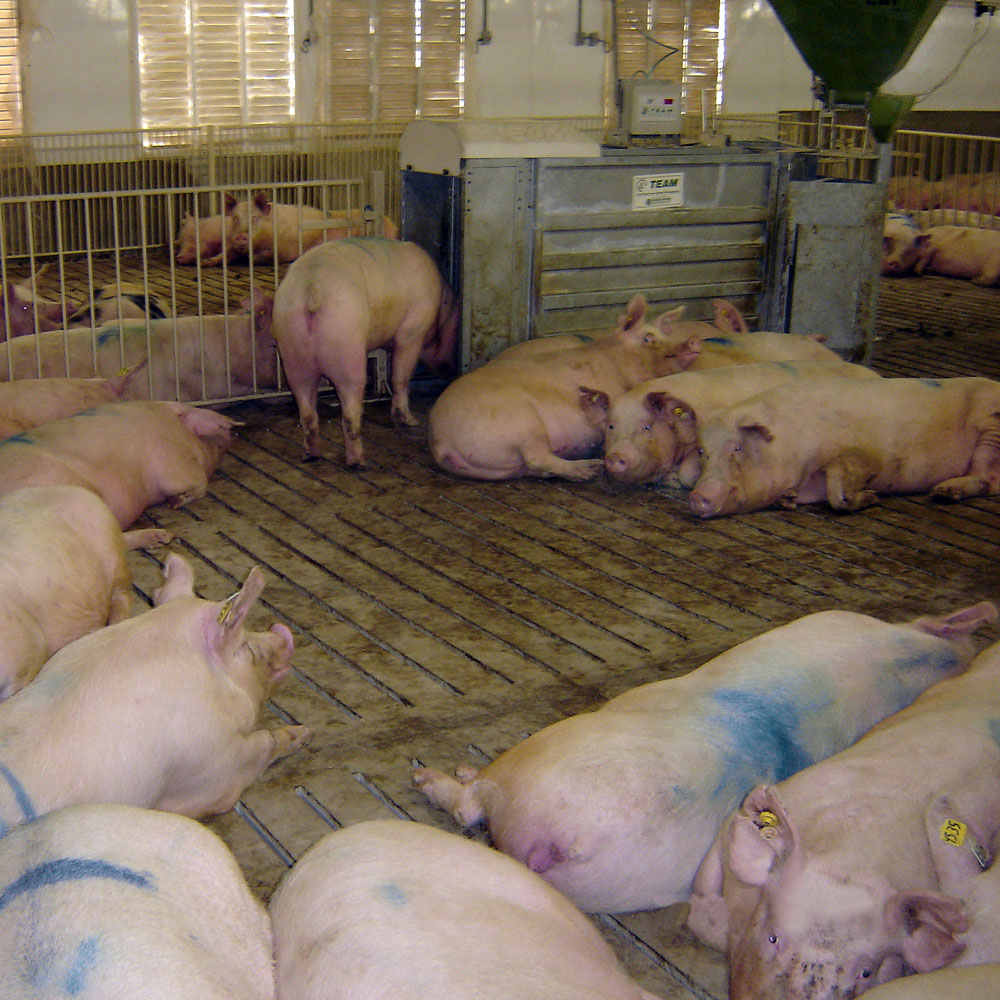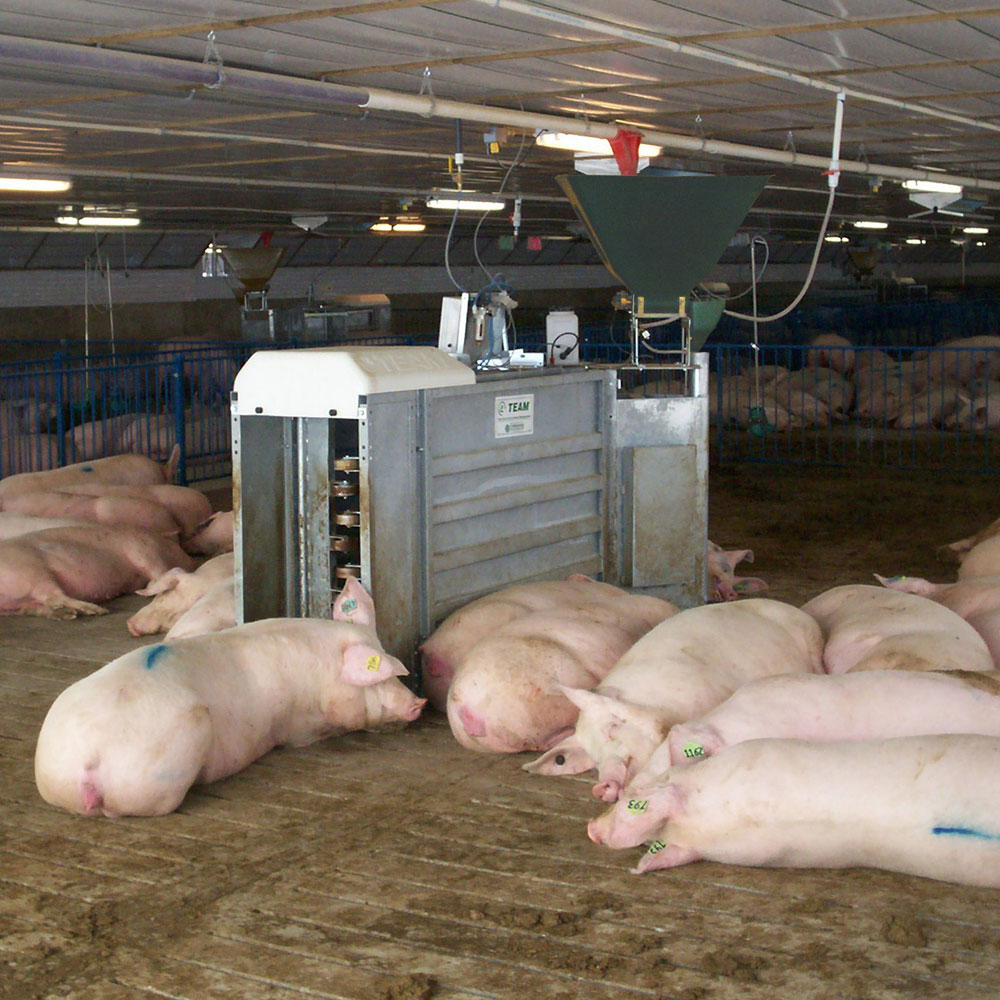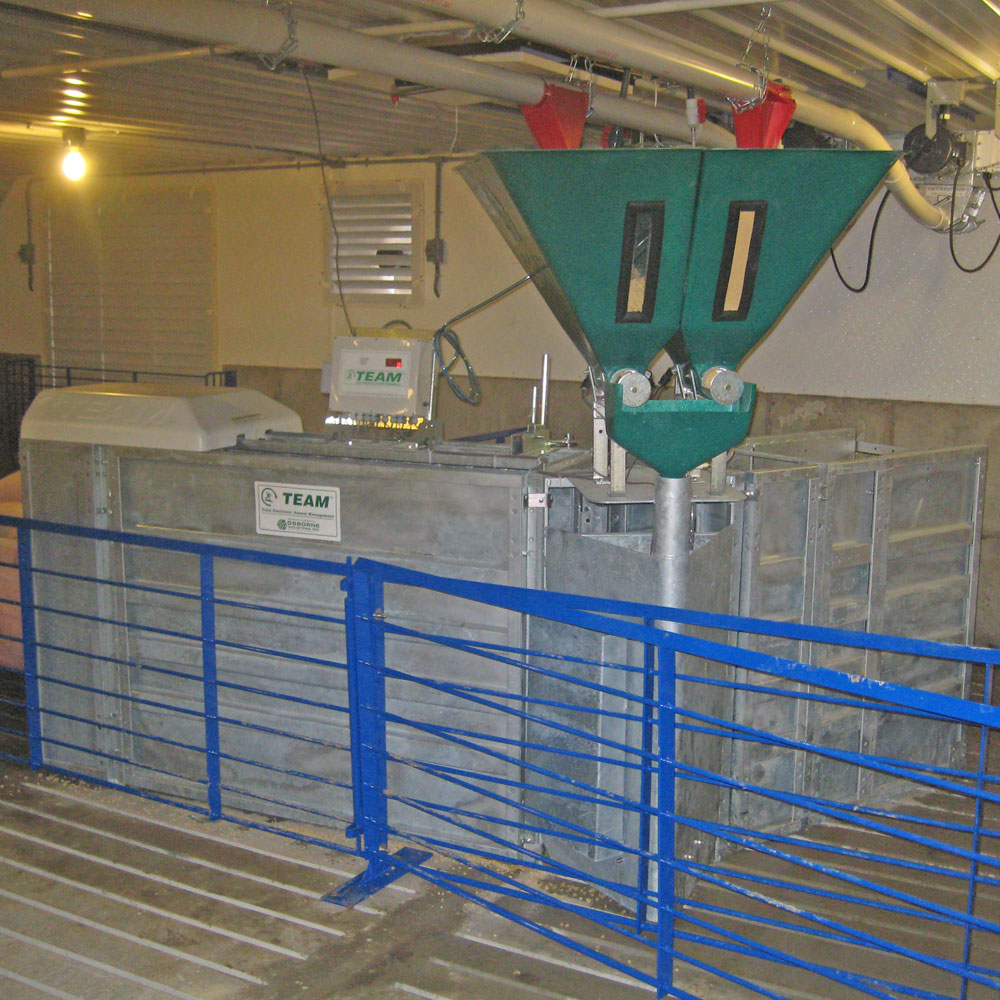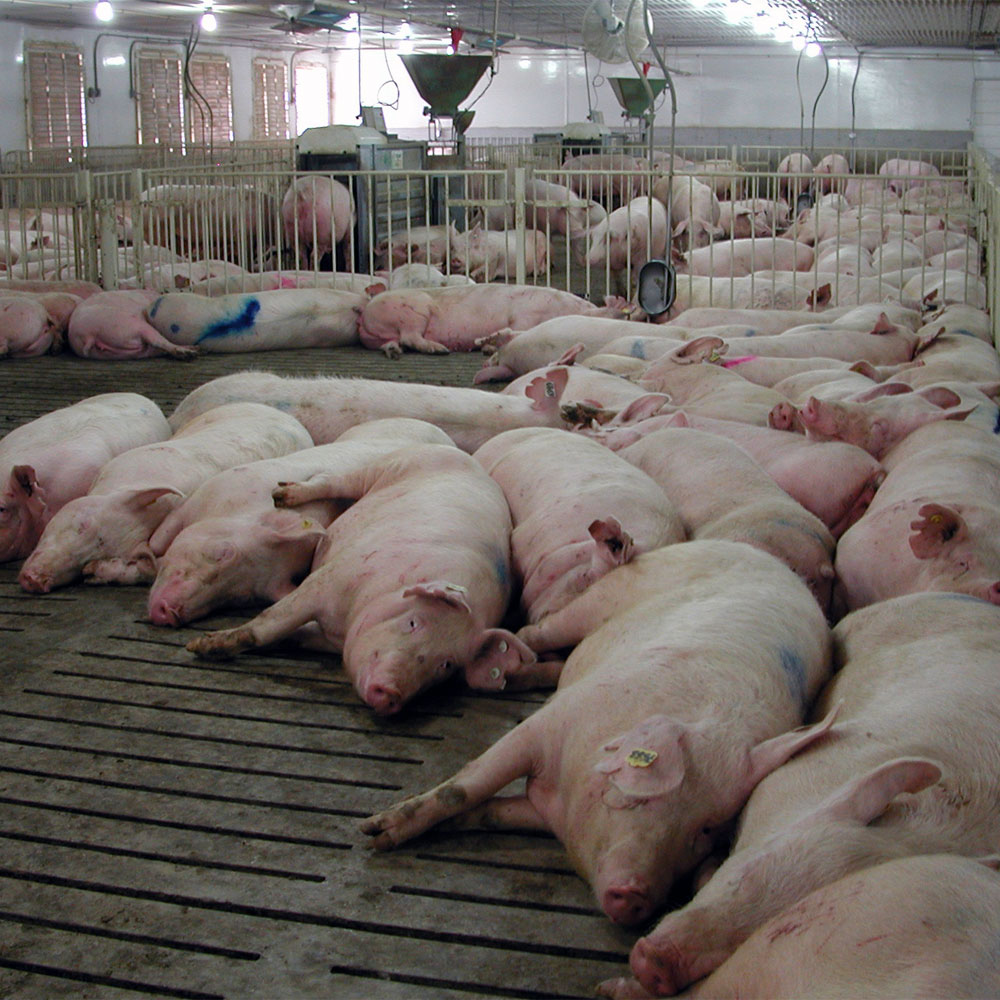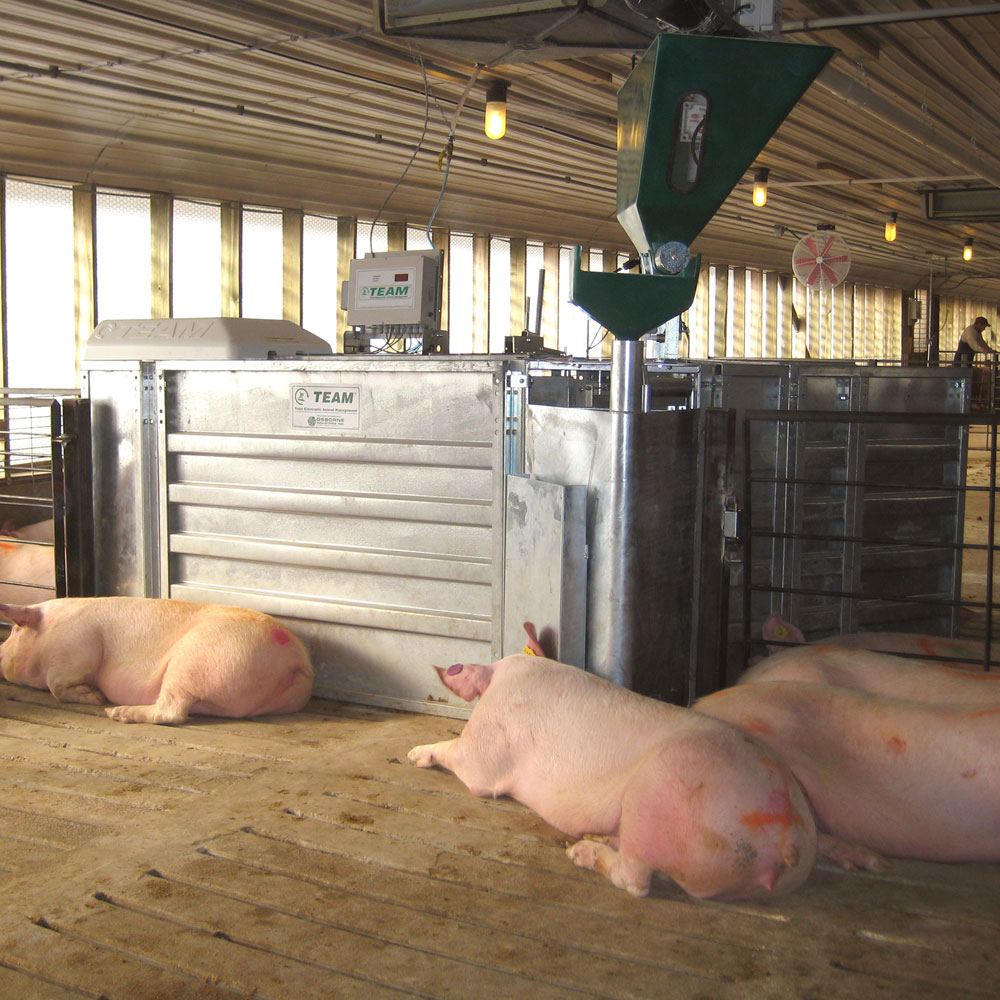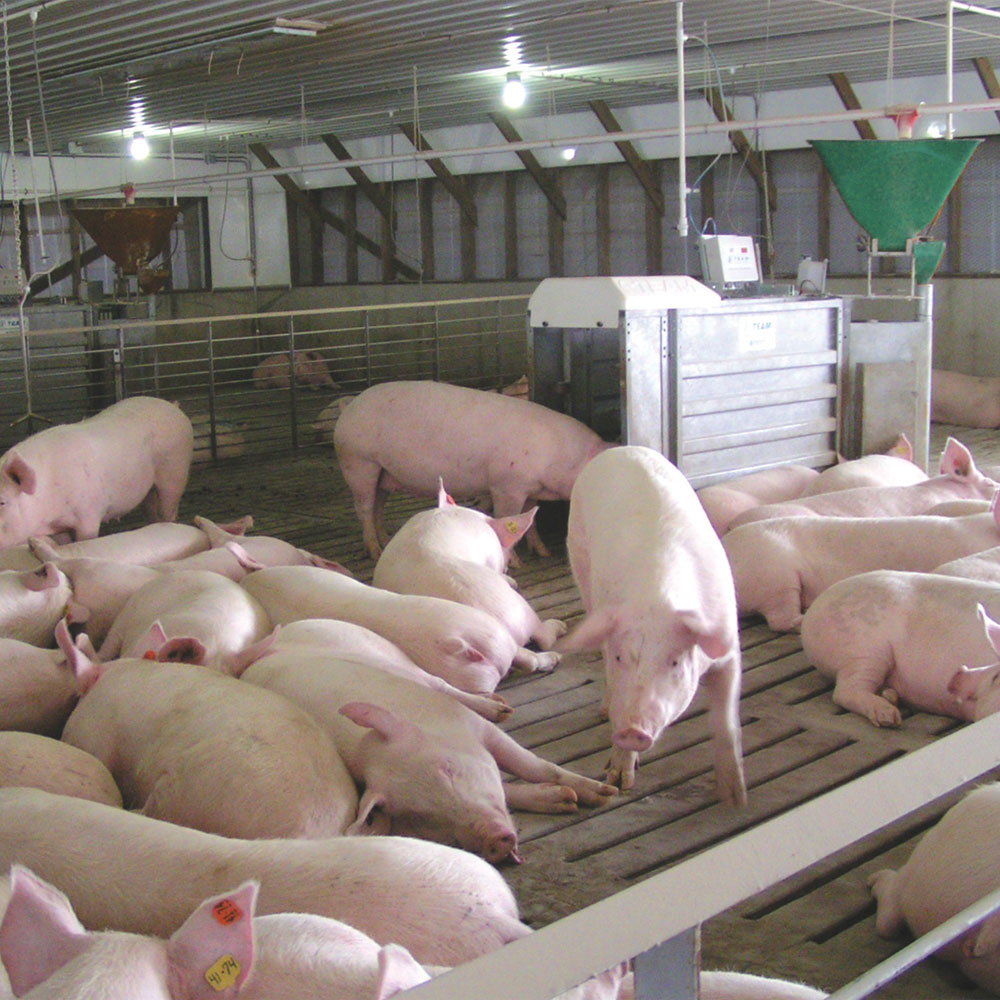Electronic Sow Feeding & Weighing
Electronic Sow Feeding (ESF) with RFID (Radio Frequency Identification) technology provides individual animal management without individual confinement. ESF assists in the total reproductive management of gestating, farrowing, and unbred sows and gilts. Decades of research shows well-managed ESF systems reduce feed waste and feeding aggression, optimize individual animal condition, and improve bottom-line profitability on the farm.
About
Individually manage and feed sows and gilts in group-housing without individual confinement.
The Osborne TEAM (Total Electronic Animal Management) System is a complete management system for gilts and gestating sows in large pen gestation. Osborne’s extensive research of animal behavior in group-housed settings has enabled the TEAM System to become one of the most reliable and proven ESF systems in the world. The simple design and operation of TEAM means less stress for you and your animals.
Today, the investment in ESF equipment is less expensive when compared to traditional stall systems, and proper facility design requires less area per animal. The requirement for animals to have the ability to freely move around is becoming more mainstream as consumers and activists demand a more humane way of animal management. Many states and companies have required the end of gestation crates. ESF with TEAM is the answer to providing top-notch, individual animal care without individual confinement.

Feeding Workstation
At the heart of any ESF system is the feeding workstation which provides individual feeding management of sows and gilts in large pen gestation. The TEAM G-Station (Gestation Station) fully optimizes feeding and managing animals by precisely feeding each animal the right amount of feed at the right time in an individual, private setting. Animal condition is optimized by feeding animals based on their individual body score, feed waste is reduce, and feeding anxiety or aggression is eliminated, resulting in docile and more productive animals.

Feeding & Weighing Workstation
Like the G-Station, ACCU-TEAM provides individual feeding management, but also record animal weights to improve target-feeding and fully optimize individual animal condition. This patented feeding and weighing workstation can be used for special applications like dam selection for mature target weight in gilt development, test the effects of differing feedstuffs and feed additives based on individual animal weights, and more.

Diverting Workstation
To assist in the management of sows and gilts in large groups, a TEAM D-Station (Divert Station) may be used to sort animals away from the main herd without individually seeking and sorting animals manually. Animals exiting the G-Station or ACCU-TEAM workstation into an alleyway are sorted by the D-Station to either return to the main herd or sorted away to another pen for pregnancy checking, vaccination or treatment, or to move to farrowing. The D-Station is typically used in large, dynamic setups with multiple feeding workstation per pen.

TEAM Software
The TEAM Software application for Windows collects, stores, and displays all individual animal information collected and maintained by TEAM workstations. Individual feed allocations, tracking and monitoring animal weights and production history, and other special reports and attentions are all set and generated with the TEAM Software.
Each sow or gilt is tagged with an RFID (radio frequency identification) tag. The TEAM System uses automated information-based workstations to perform specific “chores” based upon the animals unique identification. Both the fulfillment of these chores and the associated biometrics are collected at the workstations. Each TEAM workstation is fitted with a small computer which is responsible for identifying each animal and executing commands. Information collected at each TEAM workstation extends the ability of your farm management personnel to understand the immediate status of every animal.
TEAM workstations include the feeding workstations – G-Station or ACCU-TEAM Station – which individually feed each sow and gilt based on user-set feed allocations. In addition to feeding, ACCU-TEAM also collects individual body weights of animals visiting the feeding station. Animals are sorted with the diverting workstation or D-Station.
Each animal is automatically identified by an electronic RFID ear tag whenever it enters a TEAM workstation. The ear tag allows the TEAM workstation to assign all actions to a record for each animal so animals can be managed individually.
Successful ESF systems offer an array of benefits. Dedicated system consultants and in-house technical service personnel at Osborne custom design each ESF system based on individual site conditions, animal flow, and barn layout. Contact us to get started with ESF.
Static Layout – One Feeding Workstation per pen:

Dynamic Layout – Several Feeding Workstations per pen:

TEAM G-Station – Feeding Workstation
- Complete control of feeding sows as individuals in large pen gestation
- Sow condition is optimized by ability to feed each sow according to her condition and gestation stage
- Eliminates feed waste
- Promotes uniform sow condition
- Increases sow longevity and productive life
- Eliminates feed anxiety or aggression resulting in docile and unstressed animals
- Utilizes barn space better because more of the building footprint is available as moving room for sows
ACCU-TEAM Station – Feeding & Weighing Workstation
- Complete control of feeding sows as individuals in large pen gestation
- Optimize sow condition by feeding each sow according to her condition and gestation stage
- Reliably capture individual body weights to target feed sows and gilts
- Optimize the use of differing feedstuffs and feed additives based on individual animal weights
- Dam selection for mature target weight in gilt development
- Patented design
TEAM D-Station – Diverting Workstation
- Manage large, dynamic groups of animals with multiple feeding stations per pen
- Automatically mark and sort animals from the main herd for special treatments or to move to farrowing
- Reduce equipment investment by utilizing a single diverting station for multiple feeding stations
Literature
TEAM Electronic Sow Feeding Catalog: English | Spanish
TEAM Frequently Asked Questions (FAQ): English | Spanish
Benefits of TEAM: English
ACCU-TEAM New Product Bulletin: English | Spanish
News Articles
Genetic selection for docility is important in loose sow housing: English
Sows in Groups Preferred: English
Press Releases
Pig Producer Presents Electronic Sow Feeding (ESF) System Experience: English | Chinese
NeX Eco Populates New Sow Farm With Animals: English | Chinese
Chinese Swine Integrator Purchases TEAM Electronic Sow Feeding (ESF) System: English | Chinese
Integrator Co-operative Installs First TEAM Group Sow Management System in Japan: English
New Alliance Will Improve Sow Herd Management: English
Past, Present and Future of Sow Housing at GDPIA Trade Show: English
Based on our extensive research with electronic sow feeding since the 1980s, we have discovered that 60-65 parity segregated animals optimize the TEAM ESF workstations. For feeding (G-Station) or feeding and weighing (ACCU-TEAM Station) workstations, disadvantages were discovered when stocking more than 65 animals per station. For example, finding animals in groups larger than 65 and pig flow without mixing or sorting for larger groups are more difficult. Parity segregated animals allows for better target feeding and lessens neck fighting and vulva biting.
Additionally, the average eating time for 65 animals also suggests that this is the optimum group size. Measuring actual total time of ESF station use for any 24-hour period may suggest that open time exists on the feed station and that larger groups can be fed. This conclusion ignores periods during which animals have no desire to eat and the time required for entry and exit from the feed station. Sows and gilts prefer to eat at certain times of the day. If there are more than 65 animals using a single feeding station, some animals will be forced to eat during periods of rest.
The TEAM G-Station and ACCU-TEAM Station are equipped with a water solenoid to dispense a small amount of water into the trough with each feed dump. This quickens eating time and encourages faster clean up. Additionally, with the TEAM Software package, daily reports can be run to ensure all animals have passed through the station and consumed their daily allotment of feed. Any animals who have not passed through the feeding station are “flagged” so farm personnel can find and check on the animal.
24 hours per day x 60 minutes per hour = 1,440 minutes. If 50 sows are stocked on a TEAM ESF station, each has 28.8 minutes per day to eat. If there are 60 sows, that equates to 24 minutes per day. At 70 sows, each sow has 20.5 minutes to eat. Some sows eat slowly while others eat quickly. The system handles all types of eating behavior.
Many times, sows and gilts do not eat their full allotment on the first pass through the station. However, if she does not eat her full allotment on the first pass, she can finish it later in the 24-hour period.
Yes. Training gilts is easy with TEAM. Start gilts on the G-Station or ACCU-TEAM Station early at 22-24 weeks of age until they are to be moved to breeding stalls. Always allow ample time for training to allow gilts to walk through the station and become comfortable with their surroundings. Removeable gates should be used to funnel gilts into the feeding station. Lighting is also important for training and using TEAM. Barns should always be well lit, with lights above each station to minimize dark areas inside the feeding station. Well lit barns are key for peak reproductive performance.
An Osborne Technical Service Specialist can install each TEAM station and provide important training to farm personnel, with a special focus on training animals to use the TEAM workstations.
With proper system management, reports and information can be generated on sows and gilts that include: feed consumption, gestation length (in days), number of services, wean-to-mating, lactation length, spray marking or diverting tasks, and much more.
No, the TEAM Software allows for inputs of virtually all animal information. However, if you are already using a software program such as PigCHAMP, PIGKNOWS, MetaFarms, or Herdsman, information captured with TEAM can be exported as a .csv file for importing to other programs.
Osborne Technical Service Specialists are just a phone call or e-mail away when you are a TEAM customer. Technical Service can also service you remotely with web based software that is simple to use. Ask about our Planned Service Maintenance Program for TEAM customers. Exclusive benefits like spare parts discounts, reduced rates for on-site visits, and more are included upon signing up.
The versatility of many equally acceptable barn layout configurations may be one of the most important benefits of feeding sows with TEAM. Such versatility permits the low cost conversion of existing gestation or finishing barns to ESF, rather than investing in expensive conventional stall barns. TEAM works well on fully slatted or partially slatted floors, and the workstations can be placed in many different locations throughout the barn. By taking into account space allocation, pen shape, floor type, feed delivery, ventilation, animal flow, facility cost, lighting, and more, an Osborne Design Specialist assists each customer on proper design so each piece of equipment operates at peak performance. Additional key factors to remember include:
- Creating “zones” – Station placement creates zones inside the pen based on sow behavior. Penning should minimize sows from circling through the workstations multiple times a day, yet not obstruct animal flow into or out of the stations, or create excessive walking distances. Feeding and watering zones are common in the front or center of the pen, while loafing zones should be along the back wall of the pen.
- Static or dynamic groups – TEAM works with both static or dynamic groups. The benefits of either setup can be utilized with TEAM. An Osborne Design Specialist can assist in layouts for static or dynamic groups.
- Ample lighting – Lighting is a factor not only in training sows and gilts to use TEAM, but in reproductive performance. Not only will animals be more comfortable in well lit barns, but personnel caring for the animals will too.
Each TEAM workstation can be equipped with a variety of accessories to match your desired application. Contact Osborne for these special applications.
For TEAM G-Stations and ACCU-TEAM Stations:
- Divert Gate Kit – used to divert animals exiting the feeding station away from the main herd for special treatments, ultrasound measurements, or to move animals to farrowing.
- Switch-LOK Kit – used to split a single feeding station between two separate pens of animals.
- Spray Marker Kit – used to visually identify animals for special attention or treatments on the basis of calendar events and more.
- Second Feed Hopper Kit – provides nutrition flexibility by feeding sows different rations with a single feeding station
For TEAM D-Stations:
- Spray Marker Kit – used to visually identify animals meeting estrus detection thresholds or diverted animals.


